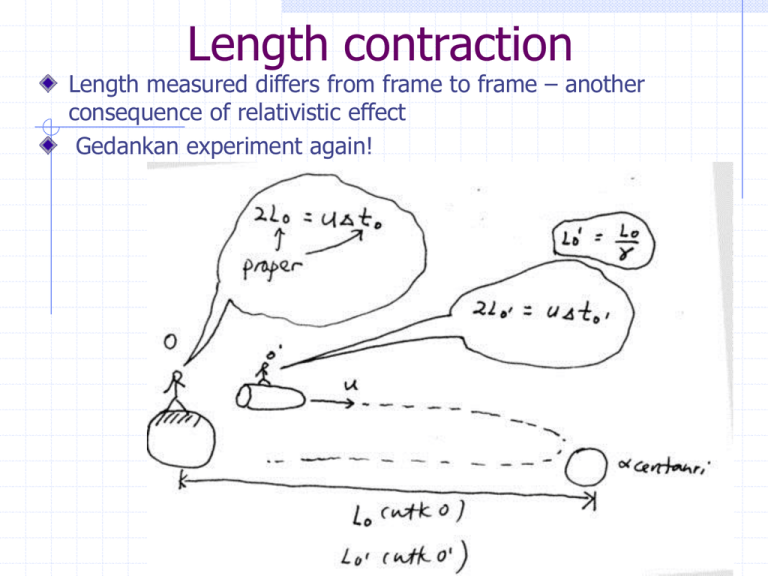lecuture4
advertisement

Length contraction
Length measured differs from frame to frame – another
consequence of relativistic effect
Gedankan experiment again!
1
Two observers: O on Earth, O’ traveling to
and fro from Earth and alpha centauri with
speed u
Total distance between Earth - alpha centauri
– Earth, according to O (Earth observer), = L0
O sees O’ return to Earth after Dt0
Observer O’ in a spaceship is heading AC with
speed u and returns to Earth after Dt’
according to his clock
2
Use some simple logics…
In O: 2L0 = uDt0
In O’: 2L0’ = uDt0’
Due to time dilation effect, Dt0’ is
shorter than Dt0 , i.e. Dt0 > Dt0’
Dt0 is related to Dt0’ via a time dilation
effect, Dt0’ = Dt0 /g , hence
L0’ / L0 = Dt0’ /Dt0 = 1 / g , or
3
L0’ = L0 / g
L0 is defined as the proper length = length of
object measured in the frame in which the
object (in this case, the distance btw Earth
and AC) is at rest
L0’ is the length measured in the O’ frame,
which is moving wrp to the object
The length of a moving objected is measured to
be shorter than the proper length – length
contraction
4
If an observer at rest wrp to an object
measures its length to be L0 , an
observer moving with a relative speed u
wrp to the object will find the object to
be shorter than its rest length by a
foctor 1 / g .
5
A stick moves to the
right with a speed u.
(a) The stick as
viewed by a frame
attached to it (b) The
stick as seen by an
observer in a frame at
rest relative to the
stick. The length
measured in the rest
frame is shorter than
the proper length by a
factor 1/ g
6
Length contraction only happens along
the direction of motion
In 3-D, the length contraction effect is a
shortening of length plus a rotation
7
8
An observer on Earth sees a spaceship at an altitude
of 435 moving downward toward the Earth with a
speed of 0.97c. What is the altitude of the spaceship
as measured by an observer in the spaceship?
Solution
One can consider the altitude seen by the
stationary (Earth) observer as the proper
length (say, L'). The observer in the spaceship
should sees a contracted length, L, as
compared to the proper length. Hence the
moving observer in the ship finds the altitude
to be
9
L = L' / g = 435 m x [1- (0.97)2]-1/2 = 106 m
Relativistic kinematics
10
Lorentz Transformation
All inertial frames are equivalent
All physical processes analysed in one
frame can also be analysed in other
inertial frame and yield consistent
results
A transformation law is required to
related the space and time coordinates
from one frame to another
11
12
O' frame uses {x',y',z‘;t‘} to denote the coordinates
of an event, whereas O frame uses {x,y,z;t}
How to related {x',y',z',t‘} to {x,y,z;t}
In Newtonian mechanics, we use Galilean
transformation
But GT must not be valid when u c because it is
not consistent with the constancy of the light speed
postulate
The relativistic version of the transformation law is
given by Lorentz transformation
13
Derivation of Lorentz transformation
14
Consider a rocket moving with a speed u (O'
frame) along the xx' direction wrp to the
stationary O frame
A light pulse is emitted at the instant t' = t =0
when the two origins of the two reference
frames coincide
the light signal travels as a spherical wave at a
constant speed c in both frames
After some times t, the origin of the wave
centered at O has a radius r = ct, where
r 2 = x2 + y2 + z2
15
From the view point of O', after some times t'
the origin of the wave, centered at O' has a radius
r' = ct‘ , (r’ )'2 = (x)‘ 2 + (y)2 + (z)2
y'=y, z' = z (because the motion of O' is along the
xx‘) axis – no change for y,z coordinates
The transformation from x to x’ (and vice versa) must
be linear, i.e. x’ x
From the view point of O:
x = ct corresponds to x ’ = 0, so we assume the form
x’ = k(x - ct ); k some proportional constant;
Likewise, from the view point of O’,
x’ = -ct’ corresponds to x = 0, so we set
x = k(x’ + ct’ )
16
With
r = ct , r’ = ct ’, x = k(x’ + ct’ ),
x’ = k(x - ct),
we solve for {x',t'} in terms of {x,t } to
obtain
x'
t'
x ut
2
u
1
c
2
t u / c x
u
1
c
2
g ( x ut)
g t (u / c ) x
2
17
the constant k is identified as the Lorentz
factor, g
Note that, now, the length and time interval
measured become dependent of the state of
motion (in terms of g) – in contrast to
Newton’s viewpoint
Lorentz transformation reduces to Galilean
transformation when u << c (show this
yourself)
18
To recap
the LT given in the previous analysis
x'
t'
x ut
u
1
c
2
g ( x ut)
t u / c2 x
u
1
c
2
g t (u / c 2 ) x
Which relates x’ , t’ to x, t’ , for which O’
is moving at velocity +u wrp to O
19
I see O’ moving with a velocity +u
I measures the
coordinates of M as
{x,t}
O
+u
Object M
O’
20
From the view point of O’
Equivalently, we could also perform the
analysis from the view point of O’ that
O is moving in the –u direction.
21
From the view point of O’
I measures the coordinates of
M as {x’,t’}
-u
O
I see O moving with a
velocity -u
Object M
O’
We wish to express x, t in terms of x’, t’
22
Mathematically, this simply
means making the permutation:
x x' , u u
x' g ( x ut) x g ( x'ut' )
t ' g t (u / c ) x t g t '(u / c ) x'
2
2
The two transformations above are equivalent; use
which is appropriate in a given question
23
Length contraction can be
recovered from the LT
Consider the rest length of a ruler as measured
in frame O’ is L’ = Dx’ = x’2 - x’1 (the proper
length) measured at the same instant in that
frame, hence t’2 = t’1
What is the length of the rule as measured by O?
The length in O, according the LT is
L’ Dx’ = x’2 - x’1 = g (x2 - x1) – u(t2 -t1)]
The length of the ruler in O is simply the distance
btw x2 and x1 measured at the same instant in
that frame, hence t2 = t1, hence L’ = g L
24
How would you recover time
dilation from the LT?
DIY as an exercise during Raya
25
Lorentz velocity transformation
M is moving with a
velocity +ux from my
point of view
I see M moving with a velocity +ux’
O
I see O’ moving with a
velocity +u
O
Object M
Object M
+u
O’
How to relate the velocity in the O’ (u’x) frame to
that of the O frame (ux)?
26
By definition, ux = dx/dt, u’x = dx’/dt’
The velocity in the O’ frame can be obtained
by taking the differentials of the Lorentz
transformation,
u
dx ' g (dx udt ), dt ' g (dt 2 dx )
c
27
Combining
dx' g (dx udt)
u
dt' g (dt u dx)
2
c
ux u
uux
1 2
c
'
x
dt
dx
u
dt dt
dt
dt dt u dx
2
dt c dt
where we have made used of the definition ux = dx/dt
28
Compare the Lorentz transformation of velocity
dx' u x u
u' x
dt' 1 u xu
2
c
with that of Galilean transformation of velocity:
dx ' d ( x ut ) dx
u'x
u ux u
dt '
dt
dt
GT reduces to LT in the limit u << c
29
Please try to understand the
definition of ux , u’x , u so that you
wont get confused
30
LT is consistent with the
constancy of speed of light
in either O or O’ frame, the speed of
light seen must be the same, c
Say object M is moving with speed of
light as seen by O, i.e. ux = c
According to LT, the speed of M as seen
by O’ is
ux u
c u c u
c u
u' x
c
u xu
cu
u 1
c u
1 2 1 2 1
c
c c
c
31
That is, in either frame, both observers
agree that the speed of light they
measure is the same, c = 3 x 108m/s
In contrast, according to GT, the speed of
light seen by O’ would be
u' x u x u c u
Which is inconsistent with constancy of speed of
light postulate
32
To recap
the LT given in the previous analysis
relates u’x to ux in which O’ is moving
with +u wrp to O,
ux u
u'x
u xu
1 2
c
33
From the view point of O’
Equivalently, we could also perform the
analysis from the view point of O’ that
O is moving in the –u direction.
We would be able to express ux in
terms of u’x in the same spirit as we
derive u’x in terms of ux
34
From the view point of O’
I see M moving with a velocity +ux’
-u
I see O moving with a
velocity -u
O
Object M
O’
I see M moving with a
velocity ux
35
Mathematically, this simply
means making the permutation:
ux u' x , u'x ux , u u
ux u
u ' x u
u'x
ux
u xu
u'x u
1 2
1 2
c
c
The two transformations above are equivalent; use
which is appropriate in a given question
36
Example
Rocket 1 is approaching rocket 2 on a
head-on collision course. Each is moving at
velocity 4c/5 relative to an independent
observer midway between the two. With what
velocity does rocket 2 approaches rocket 1?
C.f. In GT, their relative speed would just be 4c/5 +
4c/5 = 1.6 c – which violates constancy of speed of
light postulate. See how LT handle this situation:
37
38
The observer in the middle is the stationary
frame, O
Choose rocket 1 as the moving frame O‘
Call the velocity of rocket 2 as seen from rocket 1
u’x. This is the quantity we are interested in
Frame O' is moving in the +ve direction as seen
in O, so u = +4c/5
The velocity of rocket 2 as seen from O is in the
-ve direction, so ux = - 4c/5
Now, what is the velocity of rocket 2 as seen
from frame O', u ’x = ? (intuitively, u ’x must be in
the negative direction)
39
Use the LT
4c 4 c
ux u
40
5 5
u'x
c
u xu
4c 4c
41
1 2
c
5 5
1
2
c
i.e. the velocity of rocket 2 as seen from rocket 1 (the
moving frame, O’) is –40c/41, which means that O’ sees
rocket 2 moving in the –ve direction (to the left in the
picture), as expected.
40
Read other examples from the
texts and also the lecture notes
41
Selamat Hari Raya Aidilfitri
42











